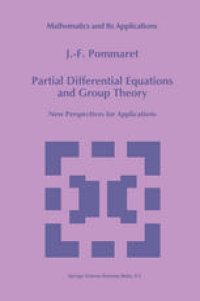
Ebook: Partial Differential Equations and Group Theory: New Perspectives for Applications
Author: J.-F. Pommaret (auth.)
- Tags: Differential Geometry, Group Theory and Generalizations, Theoretical Mathematical and Computational Physics, Thermodynamics, Systems Theory Control
- Series: Mathematics and Its Applications 293
- Year: 1994
- Publisher: Springer Netherlands
- Edition: 1
- Language: English
- pdf
Ordinary differential control thPory (the classical theory) studies input/output re lations defined by systems of ordinary differential equations (ODE). The various con cepts that can be introduced (controllability, observability, invertibility, etc. ) must be tested on formal objects (matrices, vector fields, etc. ) by means of formal operations (multiplication, bracket, rank, etc. ), but without appealing to the explicit integration (search for trajectories, etc. ) of the given ODE. Many partial results have been re cently unified by means of new formal methods coming from differential geometry and differential algebra. However, certain problems (invariance, equivalence, linearization, etc. ) naturally lead to systems of partial differential equations (PDE). More generally, partial differential control theory studies input/output relations defined by systems of PDE (mechanics, thermodynamics, hydrodynamics, plasma physics, robotics, etc. ). One of the aims of this book is to extend the preceding con cepts to this new situation, where, of course, functional analysis and/or a dynamical system approach cannot be used. A link will be exhibited between this domain of applied mathematics and the famous 'Backlund problem', existing in the study of solitary waves or solitons. In particular, we shall show how the methods of differ ential elimination presented here will allow us to determine compatibility conditions on input and/or output as a better understanding of the foundations of control the ory. At the same time we shall unify differential geometry and differential algebra in a new framework, called differential algebraic geometry.
The formal theory of systems of partial differential equations (PDEs) was developed by D.C. Spencer in the U.S.A. during 1960--1975; it studies the solution spaces of systems of PDEs without especially integrating them. It also allows the study of Lie pseudogroups, i.e. groups of transformation solutions of systems of PDEs. Although this work supersedes the classical approaches of M. Janet and E. Cartan, it is still largely unknown by mathematicians and has never been used by physicists.
This book provides a self-contained introduction to these methods, with illustrations and specific examples coming from many branches of physics, the engineering sciences and applied mathematics. The algorithms involved are presented in a way that allows the use of computer algebra for the intrinsic study of nonlinear PDEs. The book also for the first time presents the group-theoretical unification of the finite element methods for elasticity, heat and electromagnetism. The book contains the material of an intensive course which has been given many times with much success throughout Europe, and can be used for a one-year course at graduate level.
For researchers in mathematics, mathematical physics, computer algebra, control theory and theoretical mechanics.
The formal theory of systems of partial differential equations (PDEs) was developed by D.C. Spencer in the U.S.A. during 1960--1975; it studies the solution spaces of systems of PDEs without especially integrating them. It also allows the study of Lie pseudogroups, i.e. groups of transformation solutions of systems of PDEs. Although this work supersedes the classical approaches of M. Janet and E. Cartan, it is still largely unknown by mathematicians and has never been used by physicists.
This book provides a self-contained introduction to these methods, with illustrations and specific examples coming from many branches of physics, the engineering sciences and applied mathematics. The algorithms involved are presented in a way that allows the use of computer algebra for the intrinsic study of nonlinear PDEs. The book also for the first time presents the group-theoretical unification of the finite element methods for elasticity, heat and electromagnetism. The book contains the material of an intensive course which has been given many times with much success throughout Europe, and can be used for a one-year course at graduate level.
For researchers in mathematics, mathematical physics, computer algebra, control theory and theoretical mechanics.
Content:
Front Matter....Pages i-ix
Introduction....Pages 1-47
Homological Algebra....Pages 49-60
Jet Theory....Pages 61-80
Nonlinear Systems....Pages 81-137
Linear Systems....Pages 139-175
Group theory....Pages 177-258
Differential Galois Theory....Pages 259-318
Control Theory....Pages 319-389
Continuum Physics....Pages 391-456
Back Matter....Pages 457-477
The formal theory of systems of partial differential equations (PDEs) was developed by D.C. Spencer in the U.S.A. during 1960--1975; it studies the solution spaces of systems of PDEs without especially integrating them. It also allows the study of Lie pseudogroups, i.e. groups of transformation solutions of systems of PDEs. Although this work supersedes the classical approaches of M. Janet and E. Cartan, it is still largely unknown by mathematicians and has never been used by physicists.
This book provides a self-contained introduction to these methods, with illustrations and specific examples coming from many branches of physics, the engineering sciences and applied mathematics. The algorithms involved are presented in a way that allows the use of computer algebra for the intrinsic study of nonlinear PDEs. The book also for the first time presents the group-theoretical unification of the finite element methods for elasticity, heat and electromagnetism. The book contains the material of an intensive course which has been given many times with much success throughout Europe, and can be used for a one-year course at graduate level.
For researchers in mathematics, mathematical physics, computer algebra, control theory and theoretical mechanics.
Content:
Front Matter....Pages i-ix
Introduction....Pages 1-47
Homological Algebra....Pages 49-60
Jet Theory....Pages 61-80
Nonlinear Systems....Pages 81-137
Linear Systems....Pages 139-175
Group theory....Pages 177-258
Differential Galois Theory....Pages 259-318
Control Theory....Pages 319-389
Continuum Physics....Pages 391-456
Back Matter....Pages 457-477
....